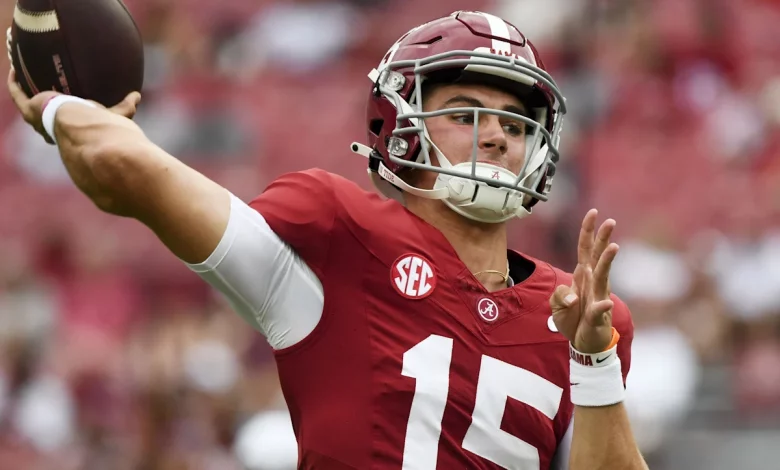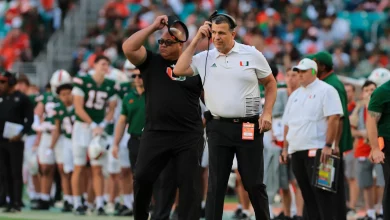Why a transfer quarterback is not necessary for Alabama football

Alabama football, under the leadership of legendary head coach Nick Saban, has long been one of the most dominant programs in college football. From its storied history to its consistent success in the modern era, the Crimson Tide has maintained a reputation for producing championship-caliber teams. However, as the landscape of college football has evolved, particularly with the rise of the Transfer Portal, Alabama, like many other top programs, has faced a new challenge—how to manage its quarterback position. While some teams have opted to bring in a transfer quarterback to fill gaps, Alabama’s situation suggests that such a move may not be necessary.
In this article, we will delve into why a transfer quarterback may not be the best solution for Alabama football, considering their current roster, recruiting success, the development of internal talent, and their broader strategic approach to building a championship-caliber team.
1. Nick Saban’s Track Record in Developing Quarterbacks
One of the primary reasons why Alabama may not need a transfer quarterback is the track record of Nick Saban in developing quarterbacks. Over the years, Saban has successfully cultivated quarterbacks who have gone on to achieve great success in the NFL. From AJ McCarron to Tua Tagovailoa and Mac Jones, Saban has shown an ability to turn talented quarterbacks into elite performers, often without relying on external transfers.
In fact, bringing in a transfer quarterback could disrupt the established system that Alabama has built over the years, where players are groomed through the program and developed under Saban’s tutelage. Saban’s philosophy has always revolved around recruiting and developing players within the system. Bringing in an outside transfer could be a departure from that philosophy and could create instability at the quarterback position, which is critical to any team’s success.
While it’s true that Alabama has had a few rocky seasons at quarterback, such as in 2023 when they struggled with consistency, the overall trajectory of the program suggests that Saban will continue to develop his young quarterbacks and create a competitive environment. Quarterbacks like Bryce Young, who won the Heisman Trophy in 2021, were not transfers—they were homegrown talent who thrived in the Alabama system.
2. Internal Talent: Jalen Milroe and Ty Simpson
One of the key reasons Alabama does not need a transfer quarterback is the talent already present on their roster. Jalen Milroe, a highly touted recruit, showed flashes of brilliance during his time as a backup quarterback in 2022 and 2023. Milroe’s athleticism and strong arm make him a dangerous dual-threat quarterback, and his development in the Alabama system could yield major results in 2025. His ability to make plays with his legs, combined with his growing understanding of the Alabama offense, gives him the potential to be a star in the coming seasons.
Another promising young quarterback is Ty Simpson, a former five-star recruit who was widely regarded as one of the top quarterbacks in his class. Simpson’s performance during his freshman year provided optimism for Alabama fans, and as he gains more experience and refines his skills, he could be a future leader for the program. The competition between Milroe and Simpson for the starting role in 2025 could fuel both players to perform at their highest level, and Alabama would be wise to let them develop rather than bringing in a transfer quarterback who might disrupt that competition.
While the temptation to bring in a transfer quarterback to immediately shore up the position may be high, the internal talent that Alabama already possesses is more than capable of leading the team to success. Milroe and Simpson represent the future of the program, and their development within the Alabama system is crucial for long-term success.
3. Alabama’s Strong Recruiting Efforts
Another reason why Alabama does not need a transfer quarterback is the program’s exceptional recruiting efforts. Saban’s recruiting prowess is well-documented, and Alabama consistently ranks among the top teams in the nation in terms of talent acquisition. The program’s ability to attract top quarterbacks out of high school has only strengthened its depth at the position.
For instance, in the 2025 recruiting class, Alabama is set to welcome another top-tier quarterback, who will join the ranks of Milroe and Simpson. This consistent influx of talent at the quarterback position means that Alabama is not reliant on transfers to fill gaps in their roster. Instead, the program has a pipeline of quarterbacks who can be developed within the system.
Recruiting is not just about landing talent; it’s about creating a system where players can grow and thrive. Saban’s ability to build a championship-caliber team through his recruiting efforts has paid dividends, particularly at the quarterback position. Alabama’s success in developing elite quarterbacks from within its recruiting classes makes the need for a transfer quarterback unnecessary.
4. The Changing Nature of the Transfer Portal
The rise of the Transfer Portal in college football has undoubtedly changed the landscape of recruiting and roster management. The ability to bring in immediate help from players who have already seen game action at other programs can be enticing for teams that are looking to plug holes. However, the Transfer Portal has also created its own set of challenges.
For one, transfer quarterbacks often come with baggage—whether it be a history of injury, inconsistency, or off-field issues. While Alabama certainly has the resources and infrastructure to handle a transfer quarterback, bringing in a player who is unfamiliar with the program could disrupt the continuity and chemistry that Alabama already has. The development of internal talent and the ability to build chemistry within the system is key to Alabama’s long-term success.
Moreover, the Transfer Portal can sometimes be a quick fix that does not necessarily address the root cause of a team’s struggles. In Alabama’s case, their quarterback issues over the past couple of seasons have been more about consistency and execution rather than a lack of talent. Bringing in a transfer quarterback may provide a temporary solution, but it might not address the bigger issue of building a sustainable, long-term program. Alabama’s focus should be on developing its young quarterbacks rather than seeking a short-term fix.
5. The Alabama Culture and System
One of the defining characteristics of Alabama football is its culture. Under Saban’s leadership, the program has built a culture of excellence, discipline, and consistency. This culture permeates every aspect of the team, from recruiting and development to game preparation and execution. Part of this culture involves fostering competition at every position, including quarterback.
By sticking with internal options like Milroe and Simpson, Alabama is reinforcing its commitment to developing players within the system. This is crucial not only for the quarterback position but also for the broader program. When players know that they have an opportunity to compete and develop within the system, it strengthens the program as a whole. The transfer portal can sometimes disrupt that internal competition, especially when players are brought in with the expectation of starting immediately.
Additionally, Alabama has a well-established offensive system that has produced numerous successful quarterbacks over the years. Whether it was Tua Tagovailoa, Jalen Hurts, Mac Jones, or Bryce Young, Alabama has consistently developed quarterbacks who are capable of running the offense at a high level. The system works, and bringing in a transfer quarterback could disrupt the cohesion and stability that the program has built.
6. Long-Term Stability vs. Short-Term Gain
While it may seem tempting for Alabama to pursue a transfer quarterback for the immediate future, the focus should remain on long-term stability. Alabama’s strength has always been its ability to reload and develop players for sustained success. Bringing in a transfer quarterback could provide a temporary boost, but it could also lead to instability if the player does not perform as expected or if they are not a good fit within the system.
By continuing to develop internal talent, Alabama ensures long-term stability at the quarterback position. Milroe and Simpson have already had the benefit of being coached by Saban and his staff, and their growth within the program will pay off in the long run. Relying on internal development rather than a transfer quarterback allows Alabama to maintain its culture and system while building towards future championships.









